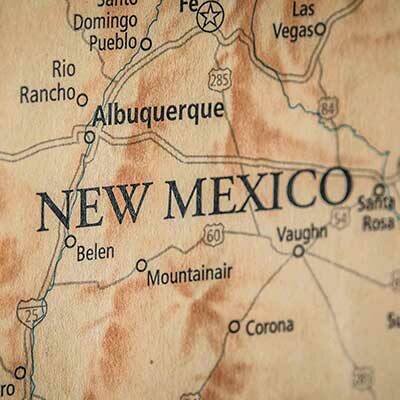New PFAS study reveals ‘forever’ pollutants persisting in NM’s waters
Laura Paskus
January 19, 2021
Winding its way through forests of conifer and aspen, cottonwoods and sycamores, the Gila River descends out of the nation’s first wilderness area, designated in 1924. For almost a century, a U.S. Geological Survey stream gage just below that boundary has tracked the river’s flows.
Now, samples from that spot reveal the presence of toxic per- and polyfluoroalkyl substances.
The channel of the Rio Puerco, where it hits Bernardo, New Mexico, is dry for most of the year, except when snowmelt or summer floods send waters churning down this tributary of the Rio Grande.
Per- and polyfluoroalkyl substances, or PFAS, have been found there, too.
The same goes for the Canadian River near Sanchez, New Mexico, and below Conchas Dam. The Pecos, San Juan, and Animas rivers. And the Rio Grande.
In cooperation with the New Mexico Environment Department (NMED), the U.S. Geological Survey (USGS) tested groundwater and surface water in 16 counties to find where PFAS are present and which specific types of those toxic substances have found their way into the state’s waters. The tests did not reveal alarmingly high levels of the pollutants at any one site. But the presence of PFAS was widespread geographically. Given their toxicity—as well as the fact that they persist within waters, soils, and bodies “forever”—the results are notable.
NMED officials were not surprised by the findings, even those high in the Gila watershed, protected since before the chemicals were invented. Rebecca Roose, director of the Water Protection Division at NMED, says that’s because “these chemicals are being discovered in ground and surface waters around the globe.”
An October 2020 study estimated that more than 200 million Americans could have the toxic chemicals within their drinking water supplies.
“Some people are going to feel like this hits a lot closer to home than others,” says Roose of the sampling results. “I think that the more people understand about the potential for contamination from PFAS chemicals in our surface waters, in our drinking water sources across the state, they’re going to want to pay attention because they care not just about the water that they, their families, and their neighbors drink—but about the whole state.”
This study is just a start, says Roose. “This is something that’s going to be an issue for us to be tackling for a very long time,” she says.
By better understanding what’s in the environment, NMED can help the public understand the risks from exposure and help local officials navigate responses to the pollution, she says. They’ll also be better able to recommend changes to the state’s existing regulatory authority so the state can hold polluters responsible—something it can’t do now in the absence of federal regulations. Currently, the federal government has only a recommended health advisory of 70 parts per trillion for an entire lifetime of exposure to PFAS.
Where are PFAS popping up?
Many of the USGS samples are concentrated in Curry and Otero counties—where PFAS from Cannon Air Force Base has contaminated drinking water supplies, private wells, and wells that supply dairies; and Holloman Air Force Base has polluted groundwater. But the study also casts a wide net around New Mexico.
Moreover, while U.S. Environmental Protection Agency studies and recommendations have focused on just two types of PFAS—perfluorooctanoic acid (PFOA) and perfluorooctane sulfonic acid (PFOS)—the new study seeks evidence of 26 other members of the toxic family, as well.
By and large, the numbers popping up in the USGS water samples are small.
The highest levels—153.2 parts per trillion of various PFAS combined—were found in the waters of the Rio Grande at Valle de Oro National Wildlife Refuge in Albuquerque’s South Valley. The Gila’s numbers came in second, at 52.6 parts per trillion.
PFAS were also picked up in the waters of the Rio Puerco near Bernardo (30.2 ppt), the Rio Grande at El Paso (22.0 and 10.4 ppt), the Canadian River near Sanchez (15.9 ppt), the Rio Grande floodway at San Marcial (10.2 ppt), the Canadian below Conchas Dam (6.9 ppt), the Pecos River near Artesia (4.9 ppt), the Animas River in Farmington (3.1 ppt), the Rio Grande at Alameda (2.8 and 2.2 ppt), the San Juan River near Archuleta (2.7 ppt), the Rio Grande above the Buckman Diversion near Santa Fe (2.3 ppt), the Pecos River near Red Bluff (2.0 ppt), and the San Juan River near Fruitland (2.0 ppt)
Samples also revealed PFAS in a groundwater well in Alamogordo (10.9 ppt) and a well in Curry County (7.0 ppt).
Slight traces of PFAS were also found in the Chama River below Abiquiu Dam, a City of Las Cruces groundwater well in Doña Ana County, a Portales well in Roosevelt County, a well at Oasis State Park in Roosevelt County, a Melrose well in Curry County, and a Santa Fe well.
The EPA’s lifetime health advisory is 70 parts per trillion—the analogy frequently mentioned is 70 grains of sand in an Olympic-sized swimming pool—but some scientists have called for stricter exposure limits. In 2018, the U.S. Department of Health and Human Service’s Agency for Toxic Substances and Disease Registry proposed a risk level equivalent of 11 parts per trillion; that same year, the European Food Safety Authority set exposure limits at roughly 6 parts per trillion.
To be sure, the new numbers coming out from the USGS study right now are tiny compared with the PFAS levels at two of the state’s Air Force bases.
In the waters below Cannon, PFAS levels were more than 370 times the EPA’s lifetime limit. And at Holloman, PFAS levels were more than 27,000 times the lifetime limit—or 1,294,000 parts per trillion.
PFAS are already a military threat in NM
More than two years ago, the military found PFAS in the waters below Cannon and Holloman Air Force bases in Clovis and outside Alamogordo—and tied the contamination to the use of firefighting foams. Now, the Pentagon is investigating whether PFAS are leaking from five other military installations in the state, including Fort Wingate, the Army National Guard armories in Rio Rancho and Roswell, the Army Aviation Support Facility in Santa Fe, and White Sands Missile Range.
After PFAS were found at Cannon and Holloman, New Mexico tried to hold the military responsible. But the Air Force sued the state, which in turn sued the U.S. Department of Defense, asking a federal judge to compel the Air Force to fund cleanup at the two bases. But the case was moved to multi-district litigation and one court in South Carolina which is overseeing all of the more than 700 separate cases regarding PFAS and the military’s use of the polluting firefighting foams. To the state’s knowledge, the Air Force hasn’t undertaken any cleanup activities at the two New Mexico bases.
The new study points to the fact that PFAS contamination is an even bigger threat—and one that extends far beyond just military bases.
At the various sites that have recently tested positive for PFAS around the state, the toxic chemicals could be coming from a variety of sources—firefighting foams and slurries, airports, electroplating factories, and manufacturers of nonstick and fireproof materials.
Right now, NMED is just trying to get a handle on where PFAS are present and what types of PFAS are showing up in New Mexico’s waters, explains Roose. The new sampling study doesn’t pin the pollution to sources. “We are also cognizant of the potentially negative repercussions of premature speculation as to the source, including for any implicated parties and in terms of preserving all future regulatory options,” she says.
Sourcing the pollution will also take more time, staff, and money. Already, the state has been scraping together funding to pay for studies like this one and others focused on known contamination from the Air Force bases. Rather than working on cleanup plans and mapping contamination, the military has largely shut down communication with the state over PFAS—and currently, the state is footing the bill to learn where PFAS contamination is spreading, even in and around the two bases and the cities of Clovis and Alamogordo.
What are PFAS?
PFAS are a class of thousands of toxic, human-made chemicals that have been linked to reproductive and developmental problems, liver and kidney disease, and immune system problems. As we’ve previously reported, exposure to PFAS has also been tied to high cholesterol, low infant birth weights, thyroid hormone disruption, and cancer, including non-Hodgkin’s lymphoma and kidney, testicular, prostate, and ovarian cancers. (To learn more about PFAS, here’s an explainer video we made last year.)
Chemicals within the PFAS family are found not only in firefighting foams—which contributed to the contamination from Cannon and Holloman—but also in common household items like weather-proof clothing, stain-resistant carpet, and nonstick cookware. Pollution in states like Wisconsin, California, and North Carolina has been tied to the manufacture of these chemicals by companies like Tyco Fire Products, a subsidiary of Johnson Controls; 3M, DuPont, DECRA Roofing Systems, and Chemours.
PFAS have earned the nickname “forever chemicals” because they don’t break down easily. First invented in the 1930s, these substances are characterized by their carbon-fluorine bonds, which are incredibly difficult to break. That makes them useful in products like nonstick cookware, metal plating, and foams that extinguish petroleum fires.
But those strong bonds also mean that in the environment, water won’t break them down. Nor will light or even microbes. These chemicals can cross the placental barrier and a mother passes them to her children when breastfeeding. PFAS also bioaccumulate, moving up the food chain. They can be passed into human bodies through milk from cows that drank contaminated water, for example, or fish or waterfowl harvested from waters containing PFAS.
Their widespread use and persistence in the environment—as well as in animal and human bodies—is just one challenge. Despite decades-old studies showing that exposure to these chemicals is related to health problems, the U.S. Environmental Protection Agency has yet to set any federal regulations limiting their presence, even in drinking water systems.
Instead, the EPA issued its lifetime health advisory of 70 parts per trillion for two of those chemicals, perfluorooctanoic acid (PFOA) and perfluorooctane sulfonic acid (PFOS).
Without federal regulatory limits—for any of the more than 7,000 toxic substances—states like New Mexico can’t hold polluters accountable. Drinking water providers aren’t required to test for them. And when they do find PFAS in drinking water systems, there aren’t effective or affordable ways to clean that water. For example, when EPCOR, which supplies water to the City of Clovis, found PFAS in about ten percent of its wells in 2019, it just shut down those wells.
Water Authority: Albuquerque’s drinking water is safe
Although the USGS study found PFAS within the waters of the Rio Grande, officials say it is not in Albuquerque's drinking water.
According to Diane Agnew, environmental manager with the Albuquerque Bernalillo County Water Utility Authority, they sampled the drinking water system in 2015 under the guidance of an EPA program—and found no evidence of PFAS in its system’s waters.
“The earlier testing, which included the outlet from our surface water plant and detected no PFAS, used methods that are comparable to those used by the USGS in their NMED study,” says Agnew. “Given the outcome of this testing, and the robust treatment system at our plant, our customers can be confident in the safety of their drinking water.”
She adds that an important next step is identifying the sources of PFAS found so far by USGS. That will put the cost of cleanup and mitigation on the responsible parties, she says, and ensure the PFAS can be controlled at its source.
The Water Authority plans to test its system for PFAS again in 2023-2025, she says, when PFAS will be included in the EPA’s next level of planned guidance.
“Waiting for these will allow the Water Authority to use EPA’s updated analytical methods, sampling design, and laboratory approvals,” Agnew says. “This will ensure that the best science is being used to monitor our system, protect our source waters, and provide the EPA monitoring data they can use in development of regulations and guidance for these compounds.”
Meanwhile, NMED must decide what to do with its limited resources and staff.
“We are every day trying to identify, address, remediate, and hold people accountable for contamination where we have it—including but absolutely not limited to PFAS—and we don’t want to take anything for granted with our water resources in the state,” says Roose.
But, she says, protecting the state’s waters from myriad threats takes time, resources, and employees.
And when the department ramps up efforts on one problem, that means pulling back on another type of contamination or issue. “Right now, we are having to make really tough choices at the department,” she says. “We’re making those kinds of tough choices every day and that limits our ability to really tackle all of the problems as cohesively and comprehensively as we’d like to.”
If you’ve been affected by PFAS contamination in your community here in New Mexico, call our tip line at (505) 433-7242. To read more coverage of PFAS in New Mexico visit “Groundwater War: New Mexico’s Toxic Threat,” which includes a timeline of events and studies on PFAS.







[…] and White Sands Missile Range. Last month, the U.S. Geological Survey and NMED also released a study showing PFAS levels in waters across New […]
[…] we covered a recent U.S. Geological Survey study of PFAS in New Mexico's waters, readers had a range of questions—including those related to private well testing, the source of […]
[…] As New Mexico PBS reported in January, when the state and the US Geological Survey tested for PFAS around the state, the highest levels—153.2 parts per trillion of various PFAS combined—were found in the waters of the Rio Grande at Valle de Oro National Wildlife Refuge in Albuquerque’s South Valley. The Gila’s numbers came in second, at 52.6 parts per trillion. […]
[…] Technical Area 15 and within waters and sludge of the LANL Wastewater Treatment Plant. They’re found in the Gila River where it gushes (or trickles, depending on the time of year) out of the nation’s first officially […]